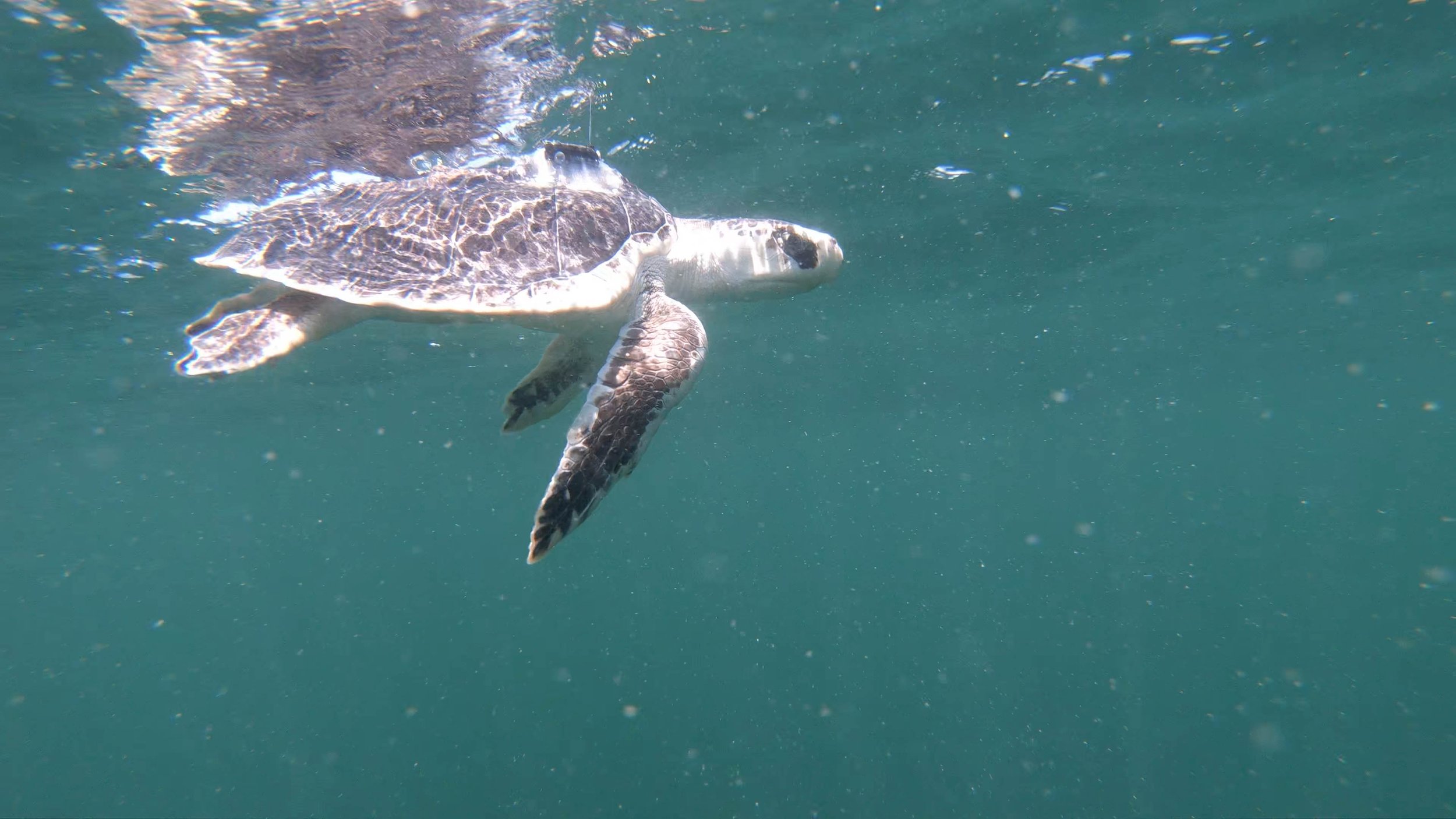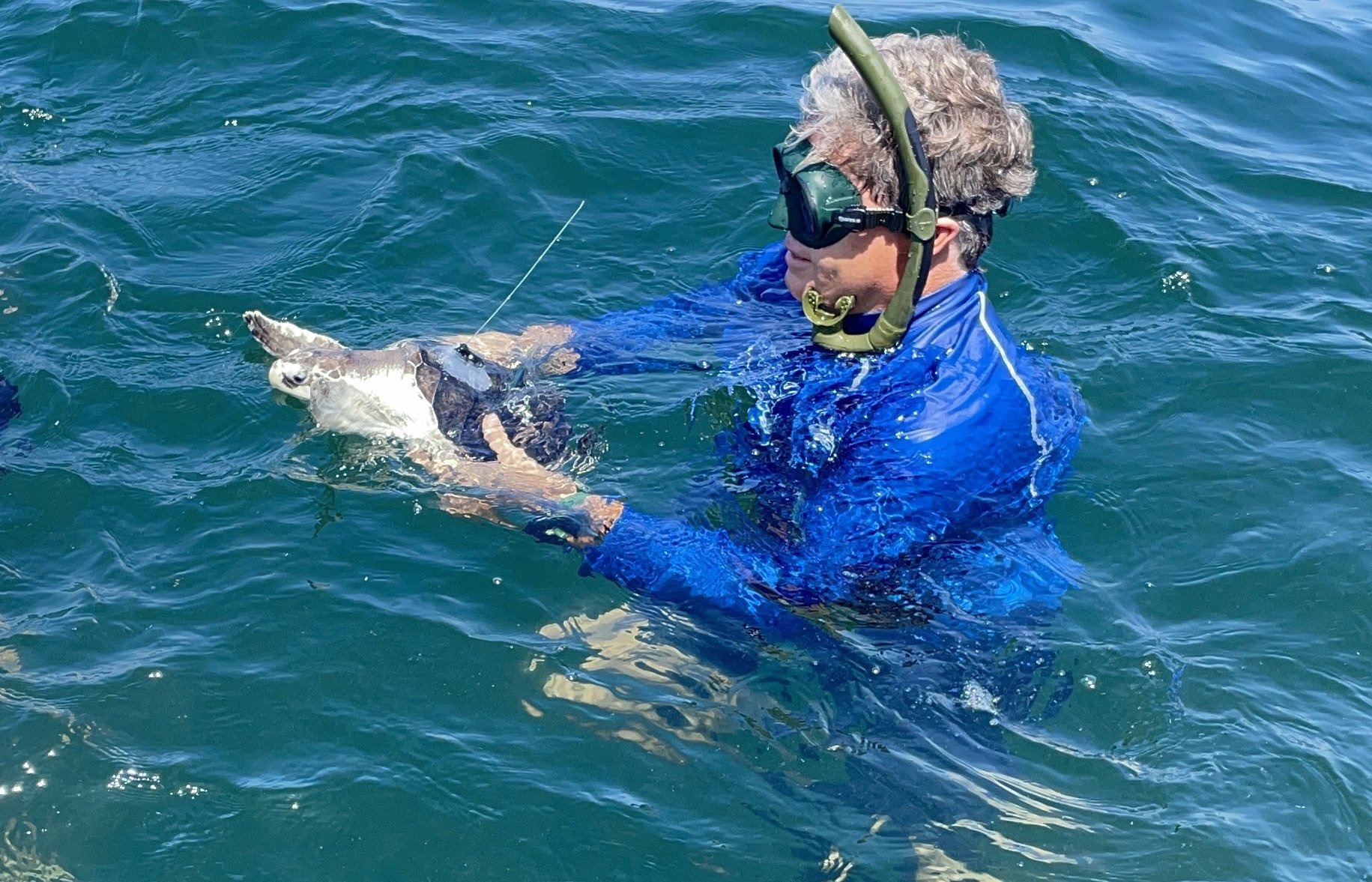Four days before Thanksgiving in 2021, cold-stunned sea turtles began stranding on the shores of Cape Cod, Massachusetts. As water temperatures dropped rapidly, the sea turtles became hypothermic. Unable to swim to warmer waters, they washed ashore. A dedicated network of volunteers and organizations sprang into action to rescue and rehabilitate the unfortunate cold-stunned turtles so they could be released back into the wild.
Upwell recently collaborated with Dr. Terry Norton and the Georgia Sea Turtle Center (GSTC) on the release of eight rehabilitated juvenile Kemp’s ridley sea turtles. The New England Aquarium and the National Marine Life Center first assessed and stabilized the cold-stunned Kemp’s ridleys. They arrived with severe pneumonia (yes, turtles can get pneumonia too). Following treatment, volunteer pilots from the organization Turtles Fly Too transported the turtles to Georgia for continued rehabilitation and eventual release back into the ocean.
Dr. George Shillinger and Dr. Terry Norton observe the rehabilitation tank. Photo credit: Brian Lee
Pilot Ed Filangeri and co-pilot Glenn Knoblach volunteered their time and expertise to give the turtles another chance at survival by transporting them from Massachusetts to Georgia. Dr. Terry Norton and his team at the Georgia Sea Turtle Center (GSTC) gave these eight young Kemp’s ridleys veterinary care they desperately needed, including antibiotics and nebulizer therapy for pneumonia. Generous supporters of GSTC “adopted” the turtles to cover the costs of their care at the facility and each turtle was named after a local tree species. Five and a half months later, seven of the eight Kemp’s ridleys were ready for release back into the warmer waters off Georgia’s coast. One remaining Kemp’s ridley from the group continues to receive care at the GSTC facility and will be satellite-tagged and released in the coming months.
Dr. George Shillinger attaches the microsatellite tag. Photo credit: Brian Lee
So little is known about where juvenile sea turtles go and how they use marine environments during their ‘lost years’ life stage. Yet Upwell’s efforts to advance in satellite tracking technology are helping to unravel this mystery. Over the past two years, Upwell has worked with Lotek Wireless to develop and refine miniature micro-satellite tags specifically for use on juvenile turtles. So, Upwell’s Executive Director, Dr. George Shillinger, was pleased to partner with Dr. Terry Norton and GTSC to deploy the micro-satellite tags on juvenile Kemp’s ridleys, one of the world’s most endangered sea turtle species.
Dr. George Shillinger releases a tagged Kemp’s ridley sea turtle. Photo credit: William Hicks
Prior to their release, each of the seven turtles were outfitted with the prototype microsatellite tags (manufactured by Lotek, Inc.) by Upwell researchers and the GSTC team. In addition to learning about their movements, we expect to learn more about the impact of different release locations. Typically, rehabilitated turtles are released into the surf from the beach. However, this time, half the turtles transported offshore by boat to be released offshore in deeper waters where turtles of this life stage may be more likely to be found. We hope this will help them avoid nearshore predation and access better foraging habitat.
This is the first time juvenile Kemp’s ridleys have been tracked using micro-satellite tags. Our preliminary results reveal the turtles are staying in the lee of the Gulf Stream, with most individuals moving gradually northwards. Only one turtle (Gingko) has moved southward and towards the coast. Redwood (22854) has traveled the farthest distance since release. Hawthorne (212863) and Magnolia (212858) have headed northwards, following the coastline. We look forward to following their progress and hope they avoid cold-stunning again!
Map by Tony Candela of Mercator Ocean International
Special thanks to New England Aquarium, National Marinelife Center, Georgia Sea Turtle Center, Jekyll Island Authority, Turtles Fly Too, Mercator Ocean International, Mass Audubon's Wellfleet Bay Wildlife Sanctuary, Dr. Jeannette Wyneken, NOAA, Latitude 31 Dive Company, Captain Kevin Honeycutt and videographers Will Hicks and Joseph Glenn!








